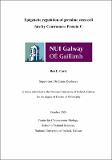| dc.contributor.advisor | Dunleavy, Elaine | |
| dc.contributor.author | Carty, Ben | |
| dc.date.accessioned | 2021-01-21T11:06:17Z | |
| dc.date.available | 2021-01-21T11:06:17Z | |
| dc.date.issued | 2021-01-21 | |
| dc.identifier.uri | http://hdl.handle.net/10379/16500 | |
| dc.description.abstract | Germline stem cells (GSCs) divide asymmetrically to produce one new daughter stem cell and one daughter cell that will subsequently undergo meiosis and differentiate to generate the mature gamete. The ‘silent sister hypothesis’ proposes that in asymmetric divisions, the selective inheritance of sister chromatids carrying specific epigenetic marks between stem and daughter cells impacts cell fate. To facilitate selective sister chromatid segregation in stem cells, this hypothesis specifically proposes that the centromeric region of each sister chromatid is distinct. In Drosophila GSCs, it has recently been shown that the centromeric histone CENP-A - the epigenetic determinant of centromere identity - is asymmetrically distributed on sister chromatids. In these cells, CENP-A deposition occurs in G2 phase such that sister chromatids destined to end up in the stem cell harbour more CENP-A, assemble more kinetochore proteins and capture more spindle microtubules. These results suggest a potential mechanism of ‘mitotic drive’ that might bias chromosome segregation.
In this thesis, we report that the inner kinetochore protein CENP-C, which binds to centromeric chromatin, is required for the assembly of CENP-A in G2 phase in GSCs. Moreover, CENP-C is required to maintain a normal asymmetric distribution of CENP-A between stem and daughter cells. In addition, we show that CENP-A is gradually lost at the centromere of GSCs over time, with depletion of CENP-C accelerating this loss of CENP-A. Finally, we show that disruption to the centromeric core in GSCs disrupts the balance of stem and daughter cells in the ovary, shifting GSCs toward a self-renewal tendency. Ultimately, we provide evidence that centromere assembly and maintenance via CENP-C is required for efficient asymmetric division in female Drosophila GSCs. | en_IE |
| dc.publisher | NUI Galway | |
| dc.rights | Attribution-NonCommercial-NoDerivs 3.0 Ireland | |
| dc.rights.uri | https://creativecommons.org/licenses/by-nc-nd/3.0/ie/ | |
| dc.subject | Stem cells | en_IE |
| dc.subject | Asymmetric Cell Division | en_IE |
| dc.subject | Germline stem cell | en_IE |
| dc.subject | Epigenetics | en_IE |
| dc.subject | Centromere | en_IE |
| dc.subject | Chromosome | en_IE |
| dc.subject | CENP-C | en_IE |
| dc.subject | CENP-A | en_IE |
| dc.subject | Natural Sciences | en_IE |
| dc.subject | Biochemistry | en_IE |
| dc.subject | Science and Engineering | en_IE |
| dc.title | Epigenetic regulation of germline stem cell fate by Centromere Protein C | en_IE |
| dc.type | Thesis | en |
| dc.contributor.funder | Irish Research Council for Science, Engineering and Technology | en_IE |
| dc.contributor.funder | Science Foundation Ireland | en_IE |
| dc.local.note | The centromere is the central locus on a chromosome, essential to faithful cell division. Here, we provide evidence that the centromere of stem cell chromosomes are differentially assembled in order to coordinate an asymmetric division of germline stem cells in Drosophila melanogaster. Moreover, disruption to this centromere asymmetry effects stem cell fate. | en_IE |
| dc.local.final | Yes | en_IE |
| dcterms.project | info:eu-repo/grantAgreement/SFI/SFI President of Ireland Young Resercher Award (PIYRA)/13/YI/2187/IE/Epigenetic Mechanisms of Stem Cell Maintenance./ | en_IE |
| nui.item.downloads | 56 | |


